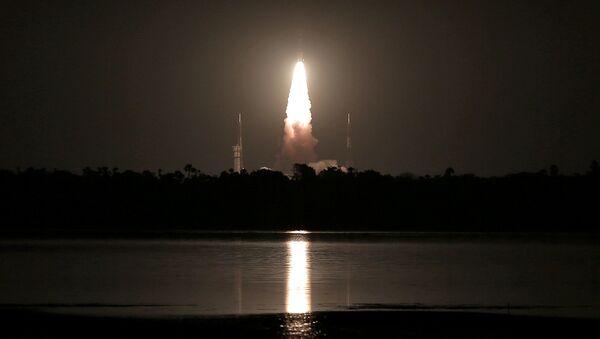The Indian Space Research Organisation (ISRO) had to delay the launch of a highly ambitious second lunar mission - only 56 minutes before liftoff of a GSLV MK III rocket carrying the three modules in the early hours of July 15.
Local media citing unnamed sources said the mission faced technical difficulties at the third stage, adding "the batteries for the cryogenic engine had not been charged". A cryogenic gas bottle leakage was also identified as another technical flaw.
Nevertheless, the space agency did not specify what kind of "technical snag" it observed in the launch vehicle system one hour before the launch.
"As a measure of abundant precaution Chandrayaan-2 launch has been called off for today. Revised launch date will be announced later", the ISRO statement read.
The launch has been pending since 2017. Four delays have occurred since March 2018. Earlier this April, Vikram, the lander, suffered an accident during testing but the space agency had claimed it managed to modify the damaged lander.
Since March 2018, the ISRO has been setting lauch dates only to postpoone them later. There were questions raised over the way ISRO had been postponing the day of launch and experts asked the agency to take time citing the complex nature of the mission. However, Ajey Lele, Senior Fellow with New Delhi based Institute of Defense Studies and Analyses (IDSA) has denied this criticism and said that the agency had taken enough time to prepare.
"No, it does not", Lele said while adding that engineers would never be in a hurry in these kinds of process.
It is believed that the Chandrayaan-2 experiment is likely to be conducted on 9 September this year. Experts believe that the deployment of the rover on the Moon's South Pole, which is generally rich in water ice and in sunlight, will help in future Mars missions.
"This is significant for the future of human presence on Moon for mining, exploration and future space travel. It is also a technology enhancer", Mayank N. Wahia, a scientist who has been participating in different kinds of experiments including GSAT satellites for the last 30 years.
After the launch of an anti-satellite missile in March of this year, more countries across the globe warned India, asking the nation to avoid the weaponisation of space.
"There is no need for such fear. India has no agenda towards space weaponsation. India has very open space programme", Lele added.
There was also a debate over the expense of the space programme about whether a developing country like India which requires massive funds to boost heathcare, education, and infrastructure should spend millions on human flight or lunar missions.
"India invests in space for the purposes of societal benefits and more than 90% of budget gets spent of such programmes. Also, if science gets boost in India that actually helps the society in the longer run", IDSA’s Senior Fellow Lele emphasised.
ISRO’s annual budget is over $1 billion, which is 10 % of NASA’s budget. But it is planning missions to Venus and Jupiter in the near future. The organisation's annual budget plan clearly indicated that the largest chunk of the space budget is used for national development - remote sensing, communication and disaster warning and management as well as resource management. "The fraction used for pure science and space exploration is small but provides new challenges to our brilliant space scientists", Vahia noted.
On 4 July, the Indian government announced that a state-run firm, New Space India Ltd. (NSIL), would begin manufacturing launch vehicles and marketing space technology. In other words, the government will commercially exploit the state-run ISRO’s space prowess. Experts feel it’s a major boost for the country's private sector as ISRO is proposing to transfer the technology to industry. ISRO is also developing a new launching system for small satellites. At present, the aim is to make a reliable and cost-effective launching system for various categories of small satellites.
"As and when GSLV Mk III matures fully, India could decide towards entering heavy satellite launch business", Lele added.



